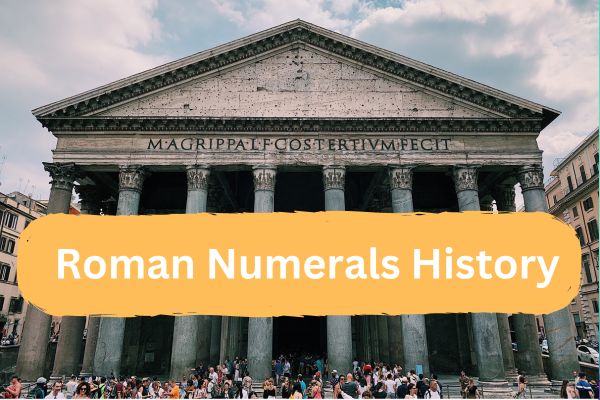Roman Numerals History: Roman numerals are an old number system that emerged from Rome city in the 8th or 9th B.C. and were used in the entire Roman empire. These numerals are expressed by the combination of letters from the Latin alphabet and provide unique and different ways of expressing numerical values. Romans used them for various purposes like counting and recording data of finance and commerce.
If you want to calculate Roman Numerals then here is the link: Roman Numerals Calculator

In the beginning stage, Roman numerals were used by people for counting objects such as livestock in business. As time passed Romans started using them for mathematical calculations and notation of dates. The Roman numerals correspond to a specific numeric value and are denoted by the sum of the values of its letters.
Roman Numerals History, Evaluation and Origin
Understanding Roman numerals is not only a window into ancient Roman culture but also an important skill for digging into historical documents, art, science and modern applications.
In this blog, you will have a deeper understanding of the rich history of Rome and Roman numbers.
Origin and development:
It is suspected that Roman numbers were first introduced by Etruscans, Etruscans are the people who belong to the place od Etruria region in Italy. The Etruria is located near the Tiber and Arno Rivers. It is believed that Romans adopted the culture of the Etruria people.
Initially, Romans used vertical lines to represent numbers, but by the time these vertical lines were mixed with alphabetic values and the Latin alphabet.
The development of Roman numbers was influenced by many cultures, civilizations and traders. As the Roman Empire grew the number system underwent significant changes also.
Structure and notations of the number system:
As I have mentioned above paragraph, Roman numbers are distinct and unique in structure from modern number systems like the Arabic number system. Roman numbers are based on seven alphabetic letters like I, V, X, L, C, D and M and each represents a special numeric value.
Here is the table of basic symbols with their values;
| Roman value | Hindu-Arabic value |
| I | 1 |
| V | 5 |
| X | 10 |
| L | 50 |
| C | 100 |
| D | 500 |
| M | 1000 |
Exploring the structure and notation system of Roman numbers enables us to understand and express numerical values in different contexts.
Historical Importance and Applications:
Historical importance is the procedure of analyzing significance of a person, things or event etc. Today, Roman numbers are used in most places like in clocks for denoting hours, in calendars in textbooks indexes for indicating lessons or subtopics numbers etc.
Limitations:
- The first limitation of Roman numbers is they are finite numbers which means one can count up to 5,000. after 5,000 we cannot count and write them, they become complex to write.
- Another limitation is that we cannot find zero in Roman numbers and also one cannot write them in fractions or decimals.
- If we use Roman numbers in everyday mathematics then it becomes a very complicated procedure for calculation as they use symbols and the Latin alphabet.
- They are more space-consuming, unlike other numbers such as Arabic numerals.
- Using them creates more confusion and leads to misunderstandings in written communication.
- When it comes to representation it is very difficult to present big numbers, which requires more symbols.
Comparison with other number systems:
| Features | Roman Numbers | Hindu-Arabic Number System | Another ancient number system like Egypt etc |
| Zero | No | Yes | It’s difficult to say because they may or may not have zero |
| Positional Value | No | Yes | May or may not have position values. |
| Calculation | Difficult to compute | Easy to compute | It depends on the number system. |
| Dominant use case | Books, Calendars Clocks etc | Modern maths and science | – |
Roman numbers have vast historical and cultural importance and they differ noticeably from other number systems in terms of representation and application and use cases etc. Understanding their background, history, applications and Limitations can help us in making decisions like when, where and how to use Roman numbers.
Our Other Calculators